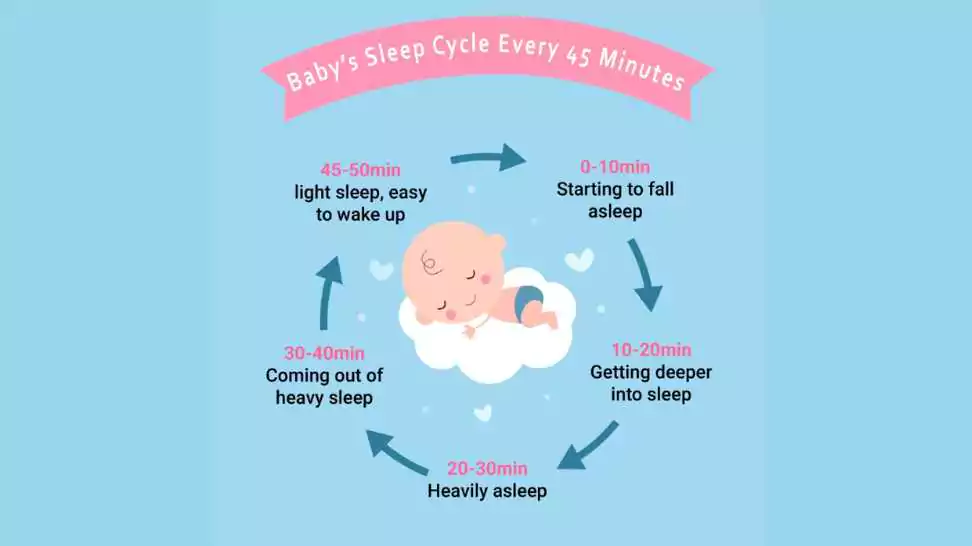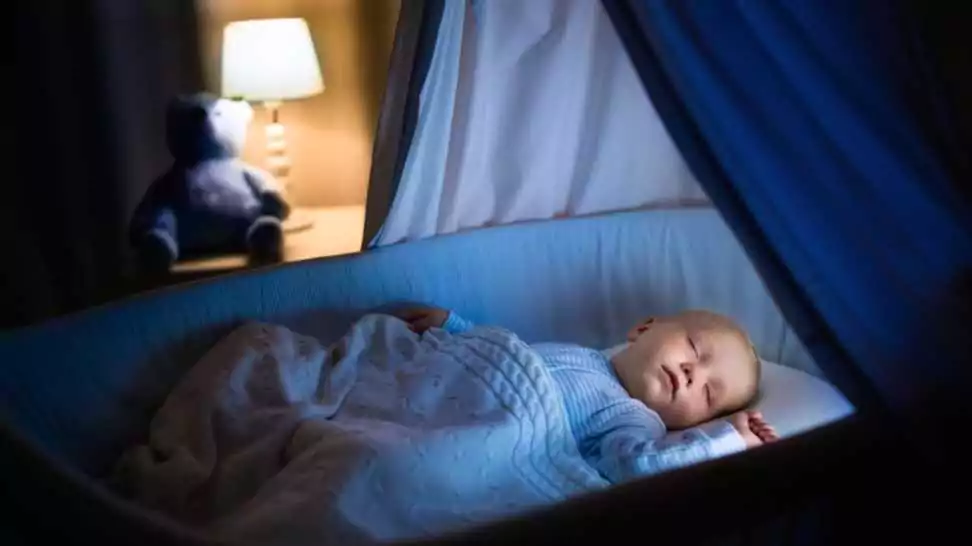Can A Newborn Baby Sleep In A Crib?

Embarking on the journey of parenthood brings its joys and a set of unique challenges, a significant one being ensuring your newborn’s safe and restful sleep. Emphasising safe sleep practices is crucial in safeguarding newborns against risks such as sudden infant death syndrome (SIDS) and other sleep-related hazards.
Many new parents grapple with decisions regarding their newborn’s sleep setup, particularly concerning the safety of cribs from the very beginning. This worry is a reflection of their deep commitment to their baby’s welfare amid an abundance of advice.
In this blog, we address the critical question: can a newborn baby sleep in a crib? We aim to tackle common concerns of new parents, illuminate safe sleep practices, and explain the ideal sleep durations for newborns. Our goal is to navigate through the intricacies of newborn sleep, debunk myths, and offer practical advice for ensuring the safety and comfort of your little one, while also providing peace of mind for you as a parent.
1 The Basics of Newborn Sleep
Overview of Newborn Sleep Patterns
Newborns, fresh to the world, experience sleep in a manner vastly different from adults or even older children. Their sleep is often unpredictable and occurs in short bursts throughout the day and night. This irregular pattern is primarily because newborns have not yet developed a circadian rhythm – the internal biological clock that regulates sleep-wake cycles in humans.
In the first few weeks, newborns may sleep for a total of 14 to 17 hours a day, but only in stretches of 2 to 4 hours at a time. This fragmented sleep schedule is normal and is influenced by their need for frequent feedings. As they grow, their sleep gradually becomes more consolidated and predictable.

How Much Sleep Do Newborns Typically Need?
The amount of sleep a newborn needs can vary, but generally, they require about 14 to 17 hours of sleep in a 24-hour period. It’s important to note that some newborns might sleep for slightly fewer or more hours and still be perfectly healthy. Parents should be aware that every baby is unique, and while sleep guidelines provide a good framework, individual variations are normal.
During the first couple of months, parents should focus on observing their baby’s sleep patterns and signals of sleepiness, such as fussing or rubbing eyes, rather than strictly adhering to a rigid sleep schedule.
The Development of Sleep Cycles in Babies

Babies’ sleep cycles are much shorter and more varied than those of adults. In the early months, a baby’s sleep cycle is typically around 50 minutes, compared to the 90-minute cycles seen in adults. During these cycles, they oscillate between REM (Rapid Eye Movement) sleep, which is a lighter stage of sleep where dreams occur, and non-REM sleep, which is deeper and more restorative.
Newborns spend more time in REM sleep, which is thought to be crucial for the extraordinary development happening in their brains. As they grow, the proportion of non-REM sleep increases, and their overall sleep cycle begins to mature and lengthen, laying the groundwork for more adult-like sleep patterns.
2 Understanding Cribs for Newborns
Features of a Safe Crib

When it comes to cribs for newborns, safety is paramount. A safe crib not only provides a secure place for your baby to sleep but also peace of mind for you as a parent. Key features to consider include:
- Size: The crib should be spacious enough to accommodate your growing baby but not so large that it poses a safety hazard. Standard cribs are designed with specific dimensions in mind, and it’s crucial to use a crib that meets these standards.
- Mattress Firmness: The mattress in a crib should be firm and flat to reduce the risk of suffocation and Sudden Infant Death Syndrome (SIDS). Soft mattresses and those that conform to the baby’s shape can create a dangerous sleeping environment.
- Spacing of Slats: The slats of the crib should be close enough together to prevent a baby’s head from slipping through or getting trapped. The recommended distance between slats is no more than 2 3/8 inches (about the width of a soda can).
The Importance of a Clutter-Free Crib
A clutter-free crib is essential for safe sleep. This means:
- No Pillows: While they might seem comfortable, pillows can increase the risk of suffocation.
- No Loose Bedding: Comforters, quilts, and heavy blankets should not be placed in the crib with a newborn. Instead, consider using a sleep sack or swaddle.
- No Toys: Stuffed animals and toys, however cute, should not be left in the crib. They can pose suffocation risks or become entanglement hazards.
Current Recommendations from Pediatric and Safety Organizations
Renowned paediatric and safety organisations, such as the American Academy of Paediatrics (AAP), have set forth guidelines to ensure the safest sleep environment for infants. These recommendations include:
- Back to Sleep: Always place babies on their backs to sleep, as this position is shown to reduce the risk of SIDS.
- Room Sharing, Not Bed Sharing: It is recommended that babies sleep in the same room as their parents, but not in the same bed, for at least the first six months.
- Avoid Overheating: Keep the room at a comfortable temperature and avoid overdressing the baby.
3 Can Newborns Safely Sleep in a Crib?
Is it Safe for a Newborn to Sleep in a Crib?
One of the most significant questions new parents grapple with is whether it is safe for their newborn to sleep in a crib. The answer is yes but with specific considerations in mind. Cribs, when used correctly, provide a safe, secure environment for a newborn to sleep. It’s crucial to ensure that the crib meets all safety standards and is set up according to the guidelines outlined by paediatric health and safety organisations.

The Role of Cribs in Sudden Infant Death Syndrome (SIDS) Prevention
Cribs play a vital role in preventing Sudden Infant Death Syndrome (SIDS), a leading cause of death in infants aged one month to one year. The design of a safe crib – a firm mattress, tight-fitting sheets, and no excess bedding or soft toys – is in line with the best practices for reducing the risk of SIDS. These practices emphasise creating a sleep environment that minimises risks such as suffocation, overheating, and entrapment, all of which are factors associated with SIDS.
Tips for Making Cribs Safe for Newborns
To ensure the crib is a safe haven for your newborn, consider the following tips:
- Use a Firm and Fitting Mattress: Choose a mattress that fits snugly in the crib without gaps on the sides where a baby could potentially get trapped.
- Opt for Breathable Bedding: Use a fitted sheet that is specifically made for the mattress size. Avoid loose bedding, heavy blankets, or any kind of soft material that could cover the baby’s face.
- Place Baby on Their Back to Sleep: Always put your baby to sleep on their back. This position is safest and significantly reduces the risk of SIDS.
- Keep the Crib Bare: Apart from a fitted sheet, the crib should be empty. That means no pillows, bumper pads, stuffed animals, or toys.
- Avoid Overheating: Dress your baby in suitable clothing that keeps them warm but not overheated. The room temperature should be comfortable for a lightly clothed adult.
- Regularly Inspect the Crib: Regularly check the crib for any loose screws, broken slats, or peeling paint to ensure it remains a safe sleeping environment.
4 How Long Should a Baby Sleep in a Crib?
Understanding the Duration: How Long Should a Baby Sleep in a Crib?
One of the common questions parents have is “How long should a baby sleep in a crib?” The answer varies depending on several factors including the baby’s growth, development, and individual needs. Generally, cribs are designed to be safe and suitable sleeping places for newborns and can continue to be so for several years.
Recommended Age Range for Crib Use
The recommended age range for crib use typically extends until the child is about 3 or 4 years old, but it greatly depends on the child’s size and development. The transition out of a crib usually occurs when a child begins to climb or outgrow the crib. Most importantly, safety should be the guiding factor in determining how long a child should sleep in a crib.
Cribs are essential during the infant stages when the risk of SIDS is highest. During this time, the controlled environment of a crib is crucial for safe sleep. As babies grow into toddlers and become more mobile, parents should assess their readiness for a transition based on their individual development.
Transitioning from a Crib to a Toddler Bed: Signs It's Time to Switch

Transitioning from a crib to a toddler bed is a significant milestone and should be handled carefully. Here are some signs that it might be time to make the switch:
- Climbing Out of the Crib: If your child is attempting to climb or successfully climb out of the crib, it’s a clear sign that the crib is no longer the safest sleep option.
- Height and Size: Once a child reaches a height where the crib’s sides are lower than the child’s chest level, the crib may no longer safely contain them.
Age and Developmental Milestones: Most children transition to a toddler bed between 18 months and 3 years of age. However, this can vary. Pay attention to your child’s developmental cues. - Verbal Expression of Discomfort or Desire for Change: If your child expresses discomfort in the crib or a desire for a “big kid bed,” it might be time to consider the transition.
- Toilet Training: If your child is toilet training and needs to access the bathroom at night, transitioning to a bed that allows for this independence is advisable.
5 Alternatives to Cribs for Newborns
While cribs are a popular choice for many parents, there are alternative sleeping arrangements that may be suitable for newborns. Understanding these alternatives can help parents make informed decisions based on their lifestyle, space, and comfort level.
Co-sleepers and Bassinets: Benefits and Considerations

Co-sleepers: These are designed to attach to the side of the parent’s bed, providing a separate space for the baby while allowing close proximity for easy night time care and feeding. Co-sleepers are ideal for breastfeeding mothers or parents who want to maintain close physical contact with their baby during the night.
- Benefits: Easy access for feeding and comforting, strengthens bonding, and may improve the mother’s sleep quality.
- Considerations: It’s essential to ensure that the co-sleeper is securely attached to the bed and that there are no gaps where the baby could become trapped.
Bassinets: Bassinets are smaller than cribs and are often portable, making them a convenient option for parents who want to keep their newborn close by during the early weeks or in smaller living spaces.
- Benefits: Portability, takes up less space and is often more affordable than a crib.
- Considerations: Bassinets have weight limits and are only suitable for the first few months until the baby starts moving more or outgrows it.
When to Use These Alternatives Over a Crib?
Choosing between a co-sleeper, bassinet, or crib often comes down to personal preference, space, and lifestyle. Here are some scenarios where you might opt for an alternative over a crib:
- Limited Space: If you’re in a smaller home or apartment where a full-sized crib might be too bulky, a bassinet or co-sleeper can be a practical choice.
- Convenience for Night time Feedings: For parents who want to minimise the disruption of night time feedings, having the baby within arm’s reach in a co-sleeper can be advantageous.
- Travel or Temporary Arrangements: If you’re travelling or need a temporary sleeping solution, a portable bassinet can be a great option.
- Preference for Room Sharing: For parents who prefer to have their newborn in the same room but not in the same bed for safety reasons, co-sleepers and bassinets offer a close-by alternative.
6 Creating a Safe Sleep Environment
Creating a safe sleep environment is one of the most crucial steps parents can take to ensure the well-being of their newborn. This environment goes beyond the choice of a sleep surface; it encompasses the overall conditions in which the baby sleeps.
Importance of Room Temperature and Clothing
Room Temperature: The temperature of the room where the baby sleeps should be kept comfortable and not too warm. Overheating has been linked to an increased risk of SIDS. A room temperature that feels comfortable for a lightly clothed adult is generally appropriate for babies.
Clothing: Dress your baby in enough clothing to keep them warm without blankets, which can pose a suffocation hazard. Sleepsacks or wearable blankets are excellent alternatives to keep your baby warm and safe.
Positioning Your Baby for Sleep: Back vs. Stomach Sleeping
Back Sleeping: The American Academy of Paediatrics recommends that healthy infants be placed on their backs for sleep, as this position has been shown to significantly reduce the risk of SIDS. Back sleeping ensures that the airway remains open and unobstructed.
Stomach Sleeping: Sleeping on the stomach or side has been associated with a higher risk of SIDS. These positions can potentially lead to breathing difficulties or cause the baby to overheat.
Monitoring and Maintaining a Safe Sleep Environment
Monitoring: Using a baby monitor can help parents keep an eye on their baby during sleep. Monitors range from basic audio models to advanced video and movement-detecting devices. Choose a monitor that fits your needs and gives you peace of mind.
Maintaining a Safe Environment: Regularly check the sleeping area for hazards such as loose bedding, cords, or small objects that the baby could reach. Ensure the sleep surface remains firm, the crib is sturdy, and the room is well-ventilated.
Parental Awareness: It’s important for parents to be aware of the latest safety guidelines and recommendations regarding infant sleep. These guidelines can change as new research emerges, so staying informed is key.
7 Wrapping Up
In this blog, we have explored various aspects of newborn sleep, particularly focusing on the safety and suitability of cribs. We discussed the basics of newborn sleep, and the features of a safe crib, and addressed the crucial question of whether it is safe for a newborn to sleep in a crib. We also looked into the duration for which a baby should sleep in a crib, explored alternatives like co-sleepers and bassinets, and highlighted the importance of creating a safe sleep environment.
The importance of adhering to safe sleep guidelines cannot be overstated. These guidelines are designed to protect the most vulnerable members of our families during their most defenceless hours. While general advice can be given, it’s essential to remember that each child is unique. Therefore, it’s always advisable to consult with your paediatrician to get personalised advice tailored to your baby’s specific needs.
As new parents, your journey is filled with learning and adjustments. By staying informed and vigilant about safe sleep practices, you can ensure that your little one not only sleeps well but also safely.
Community Q&A
About This Article
This article has been viewed 136 times.



